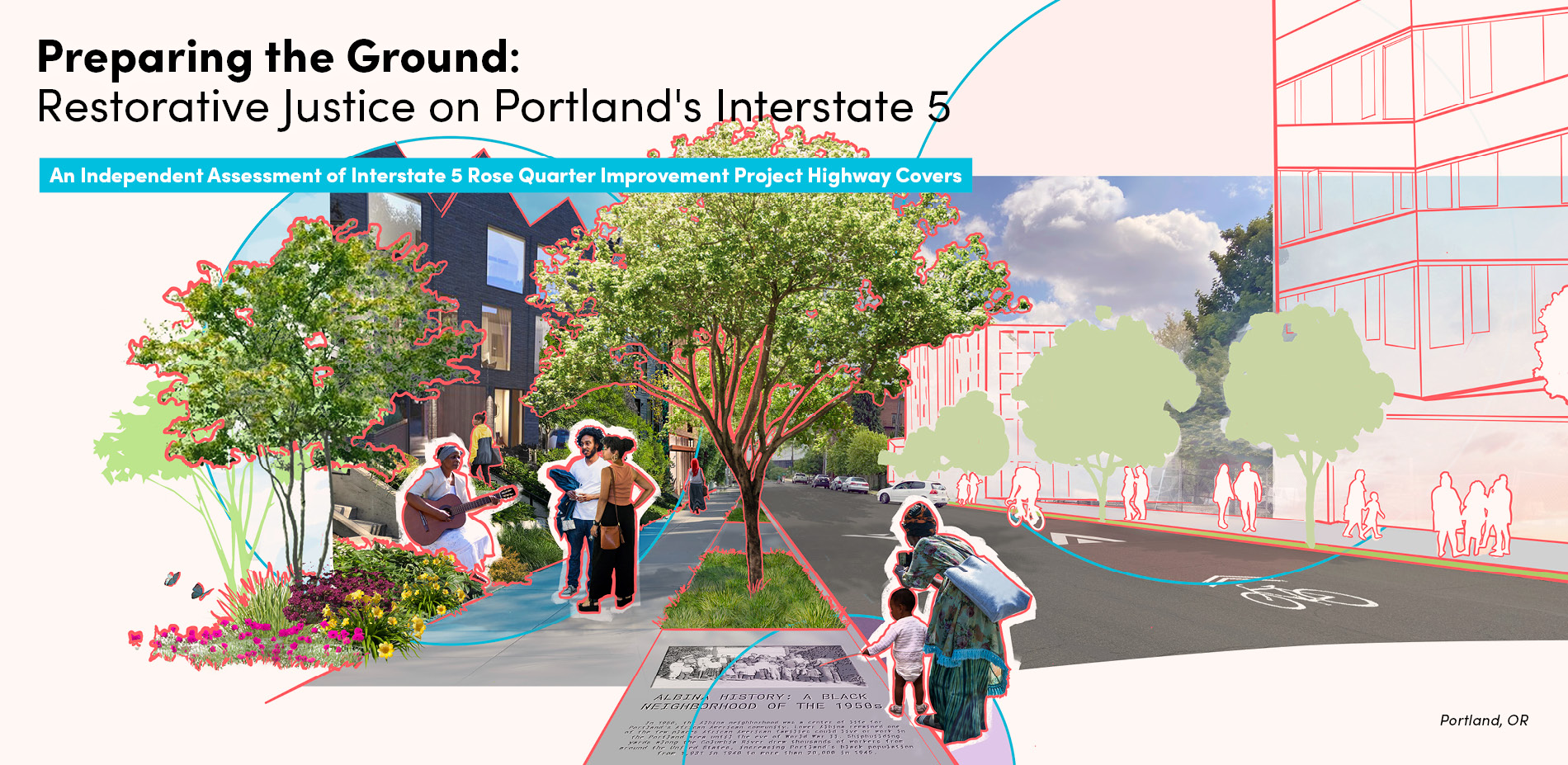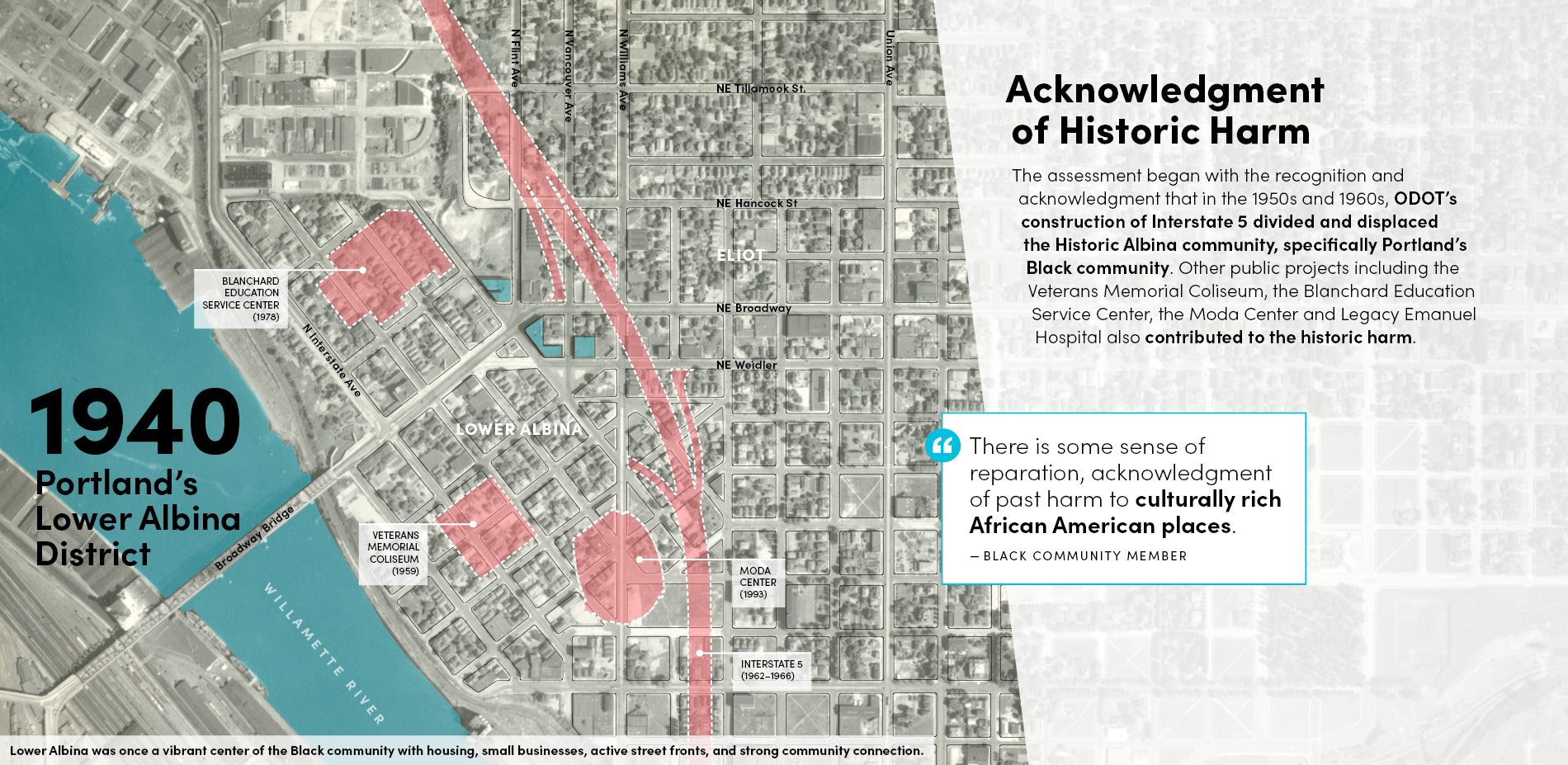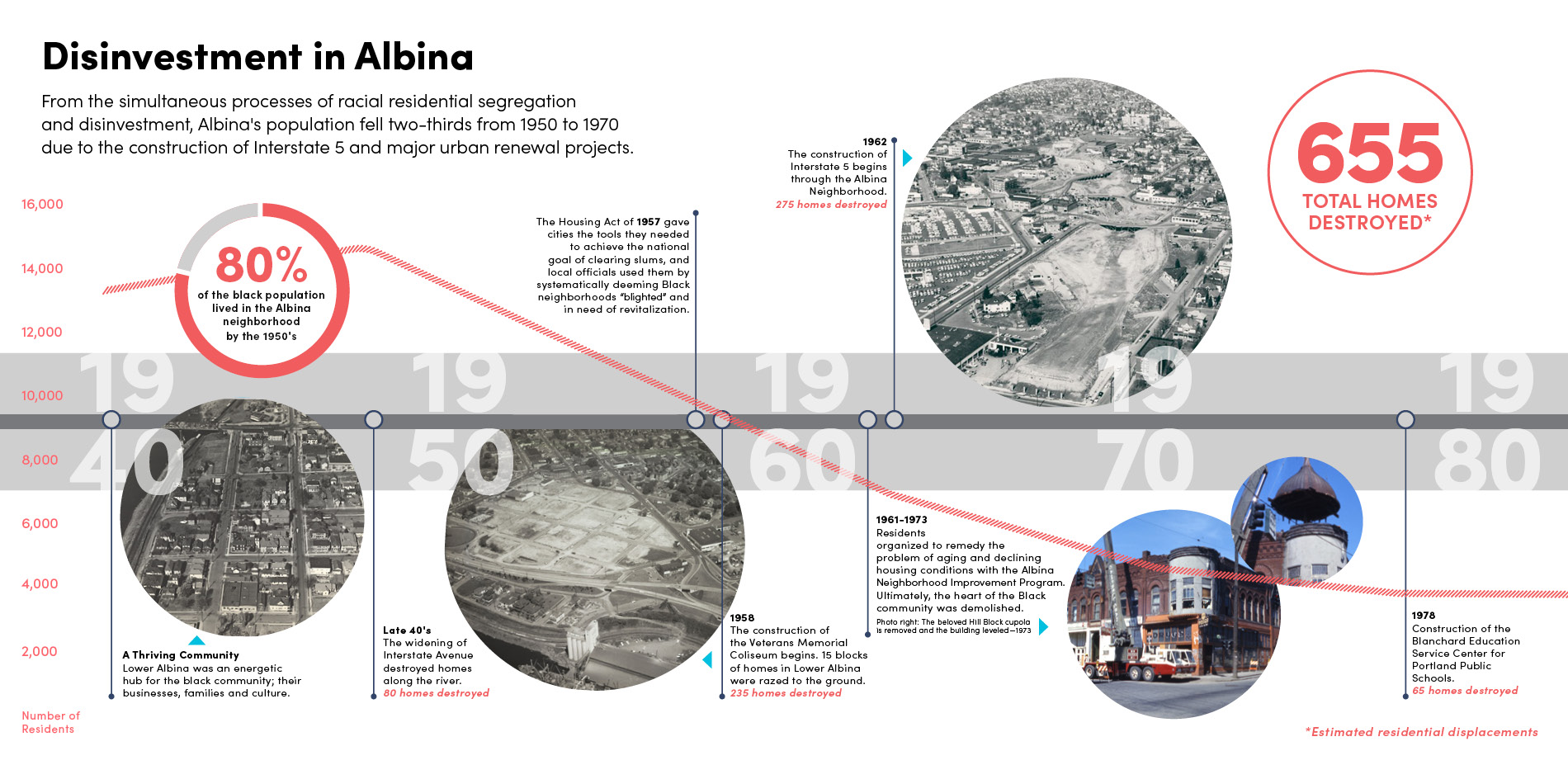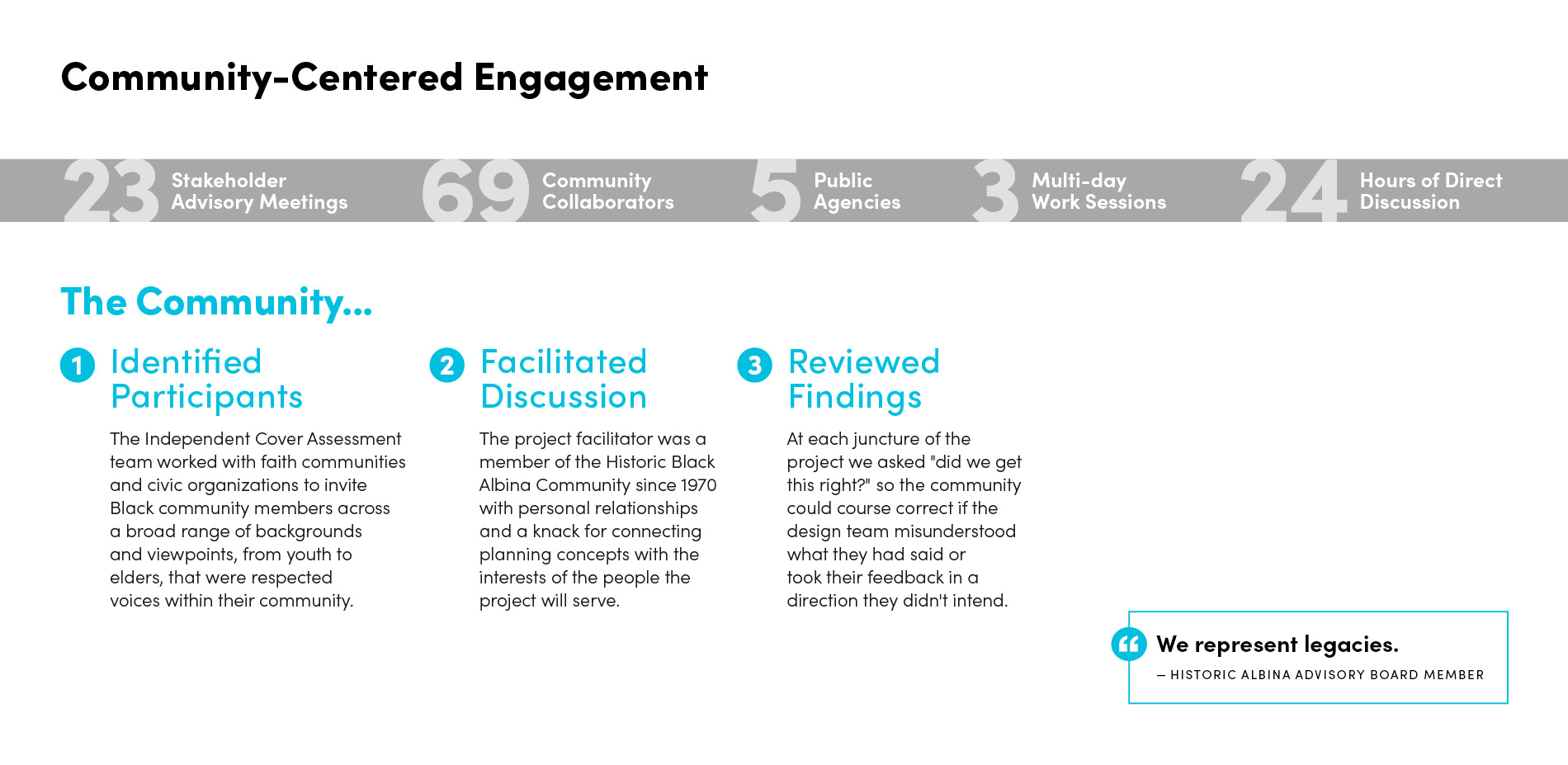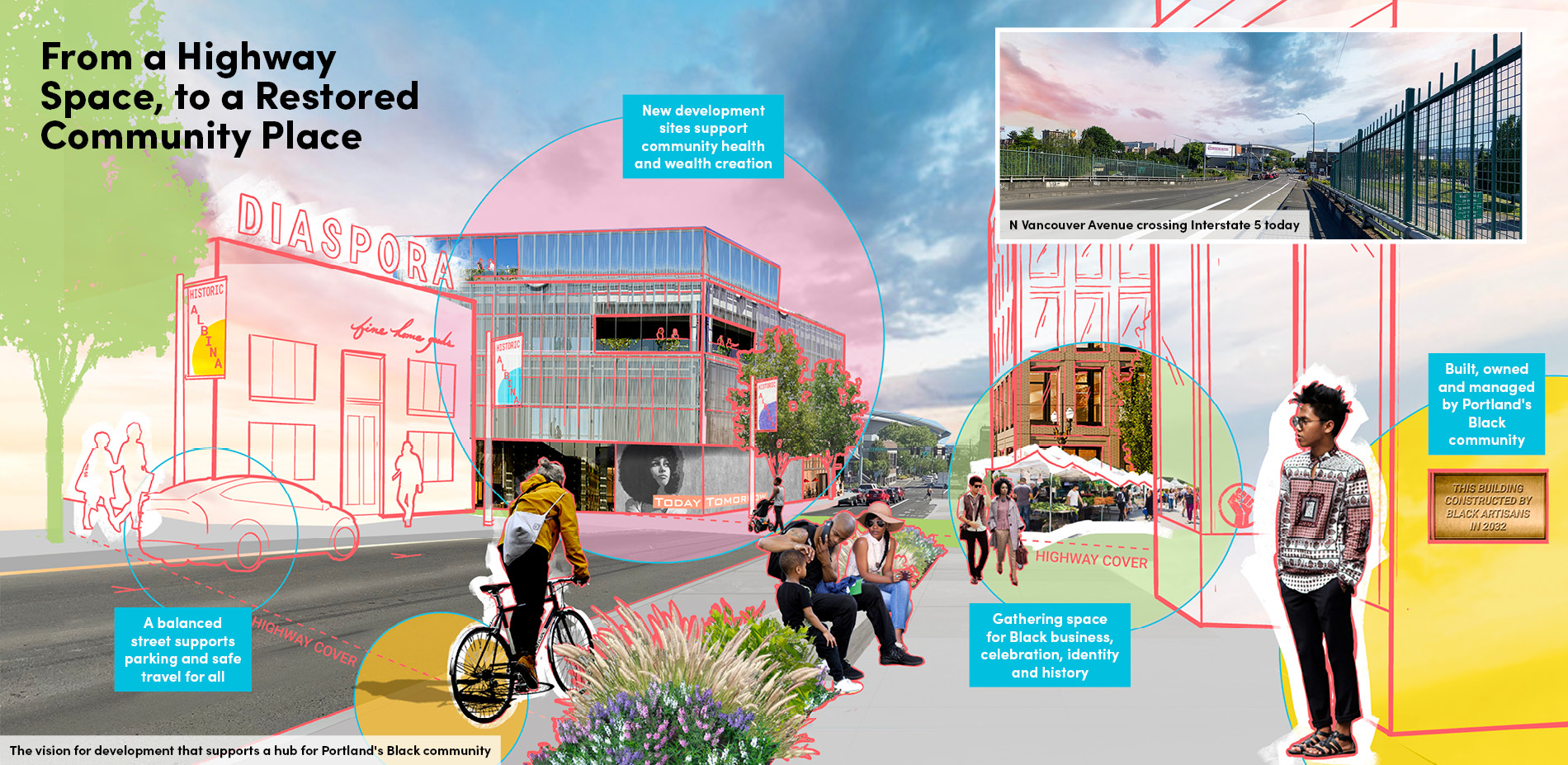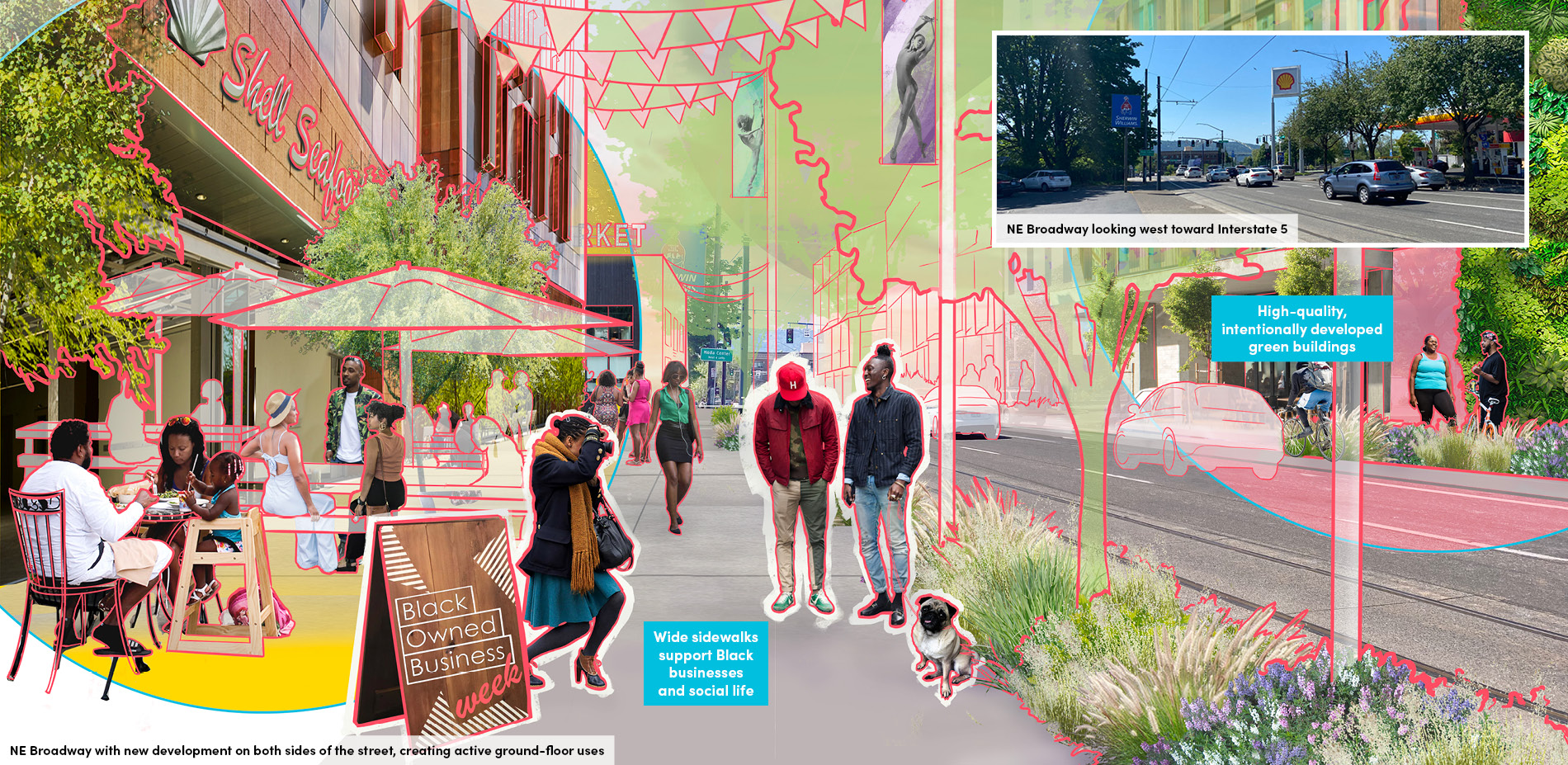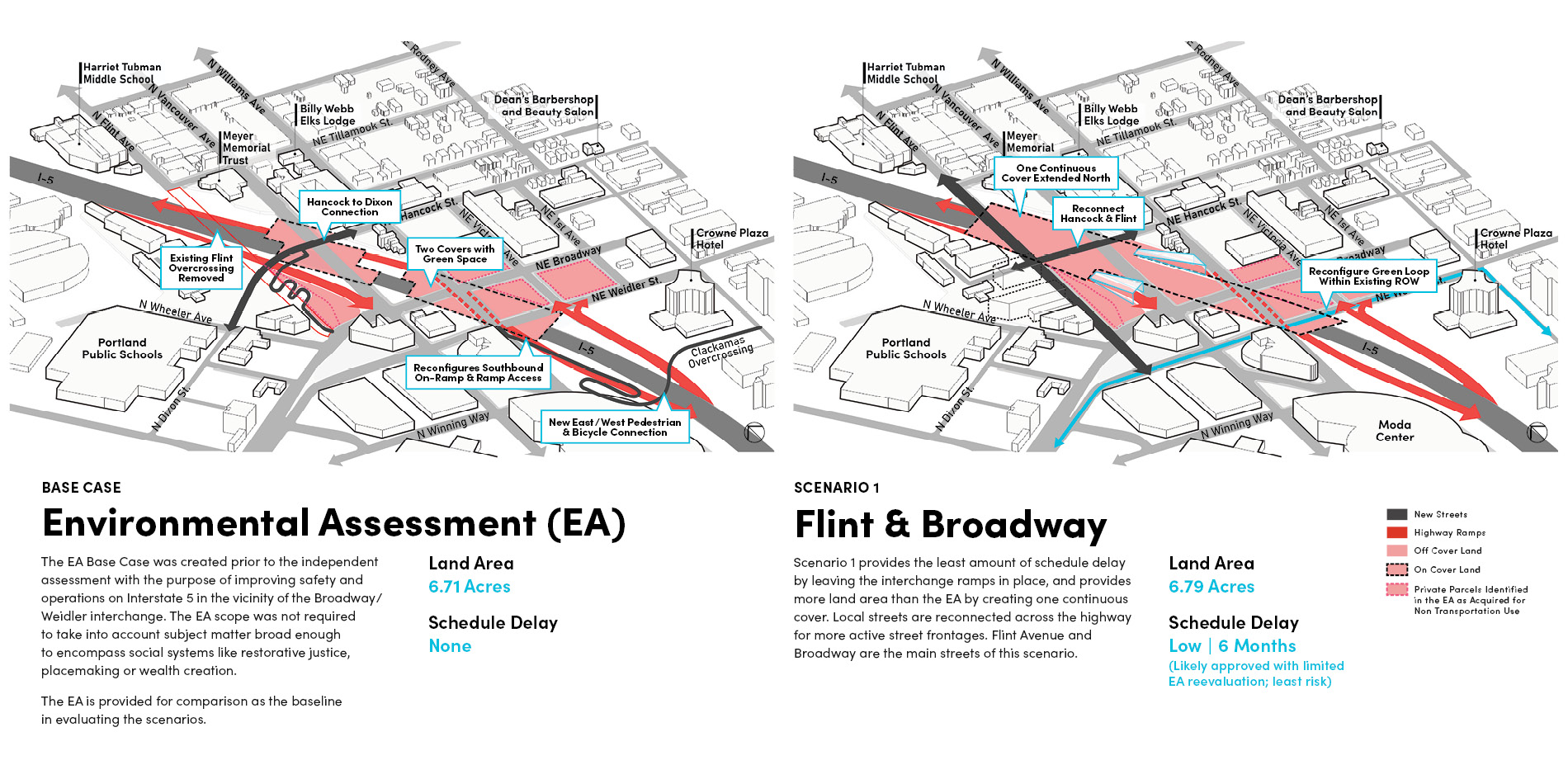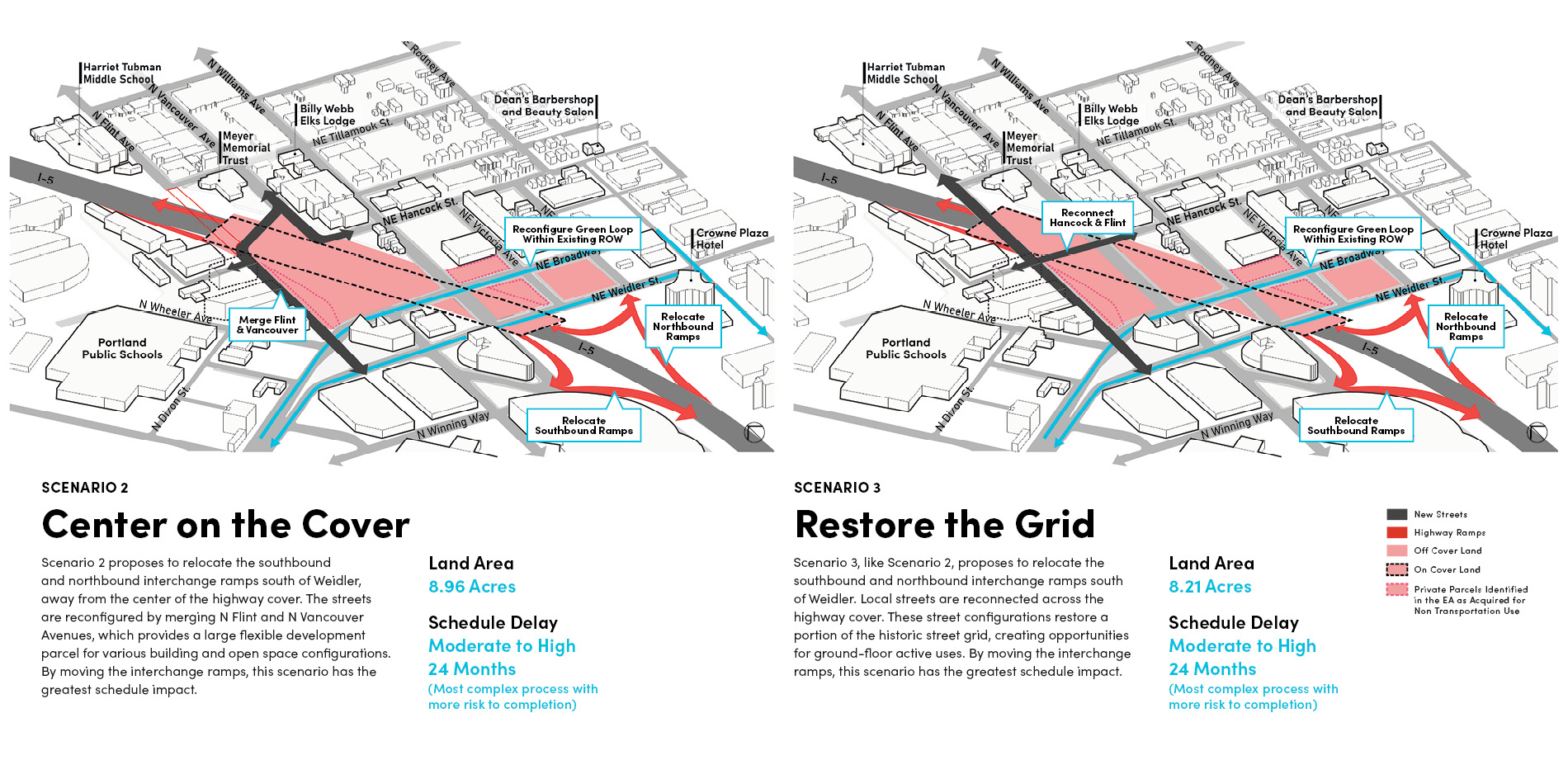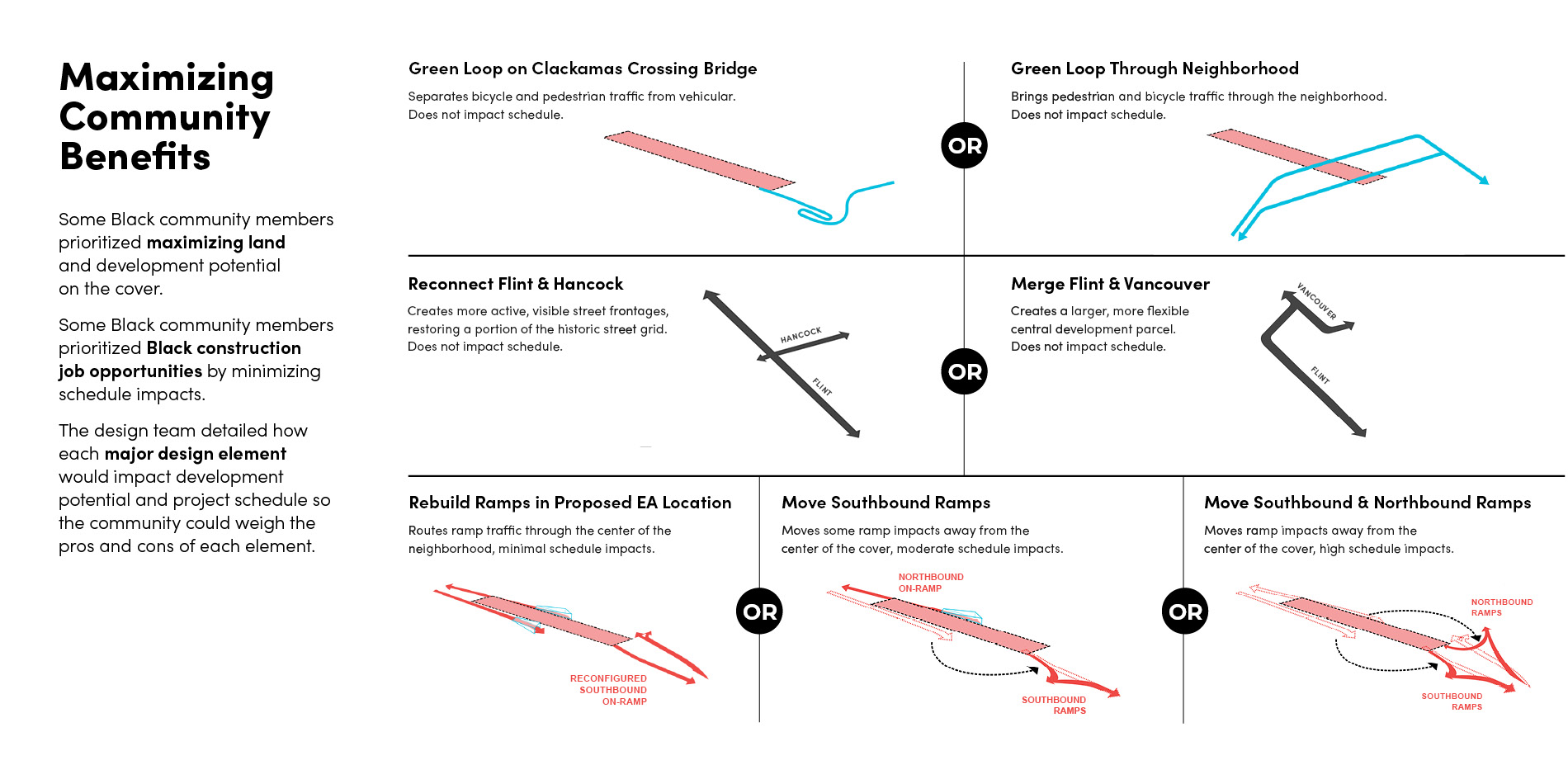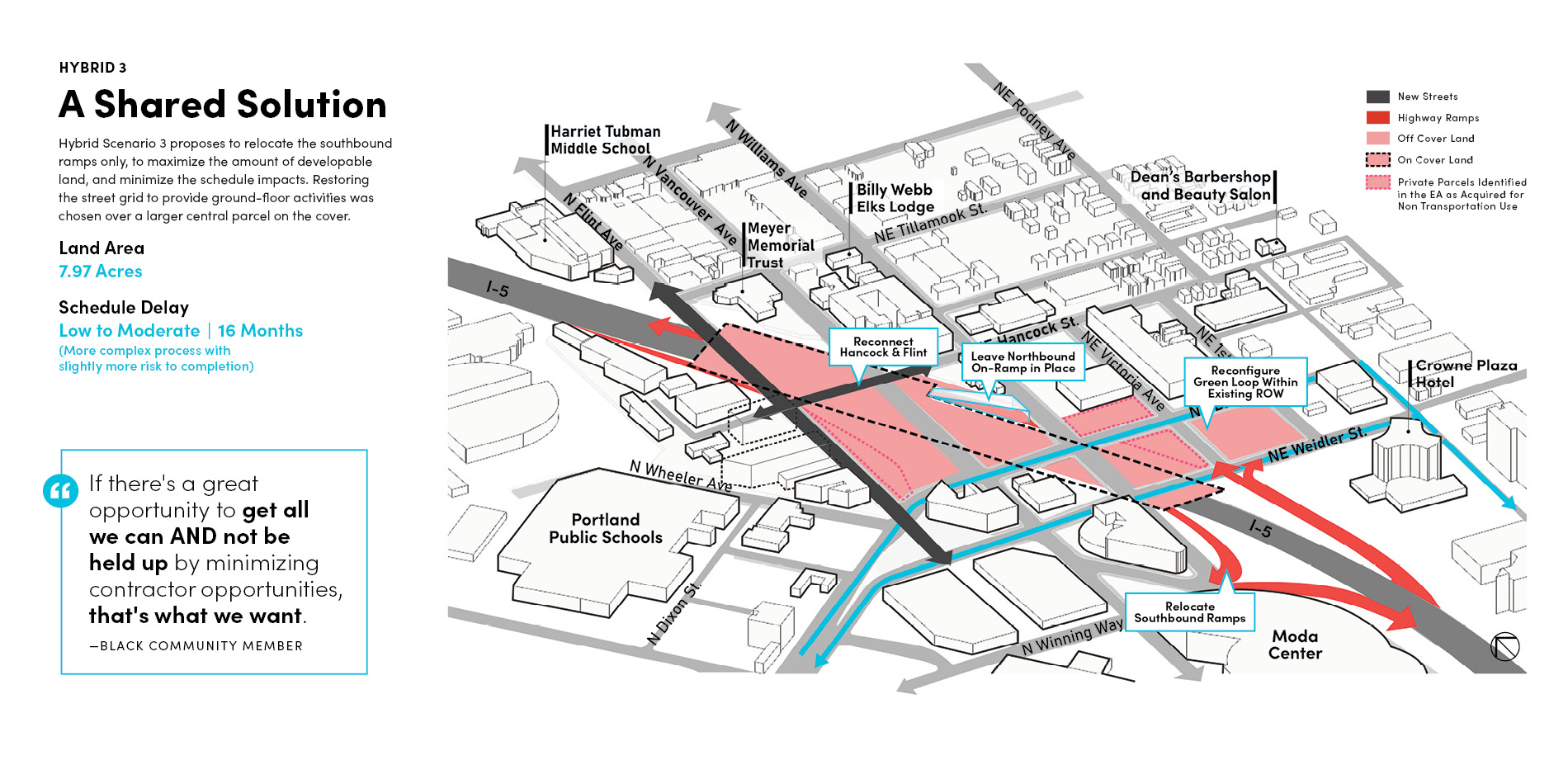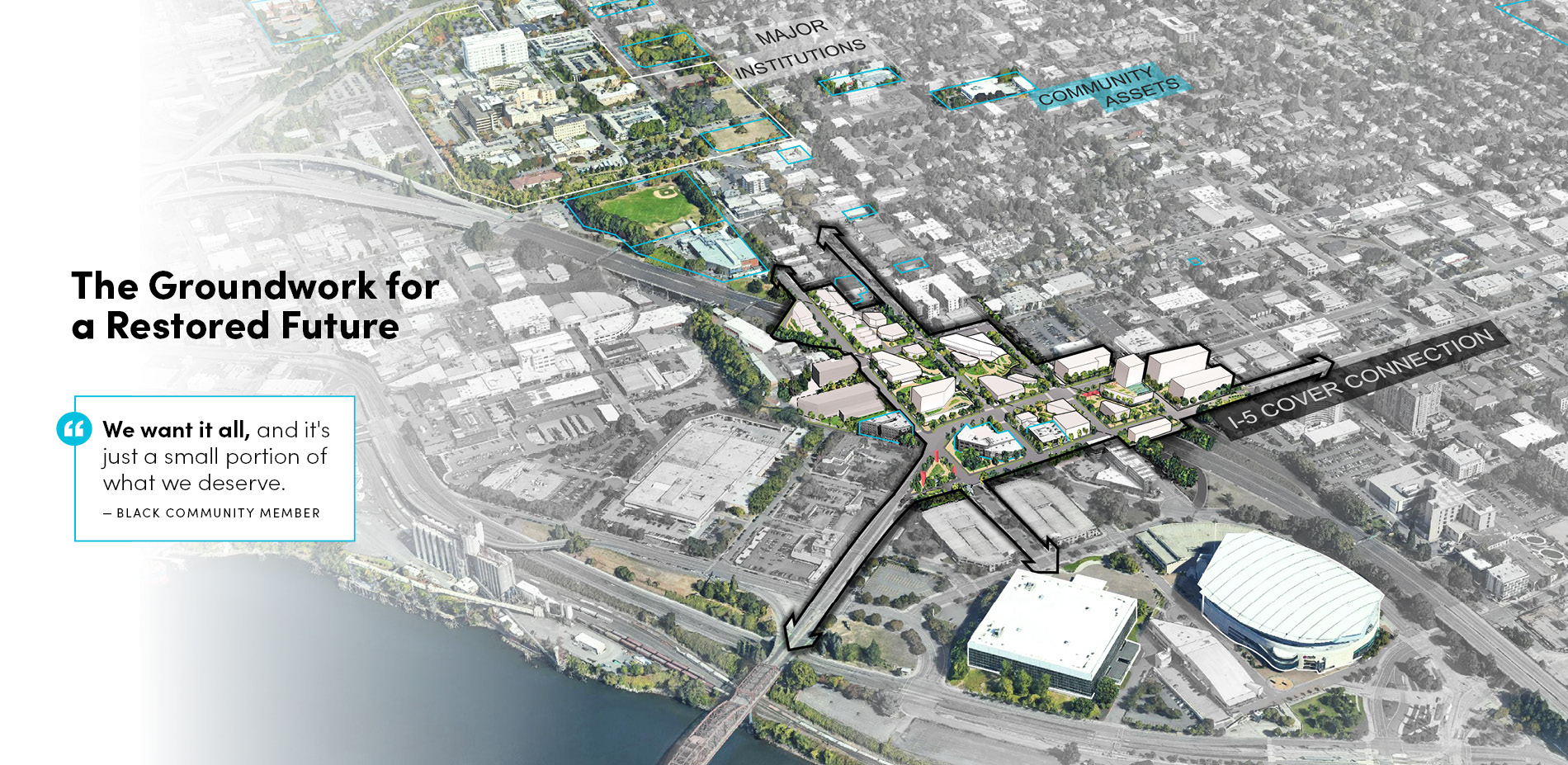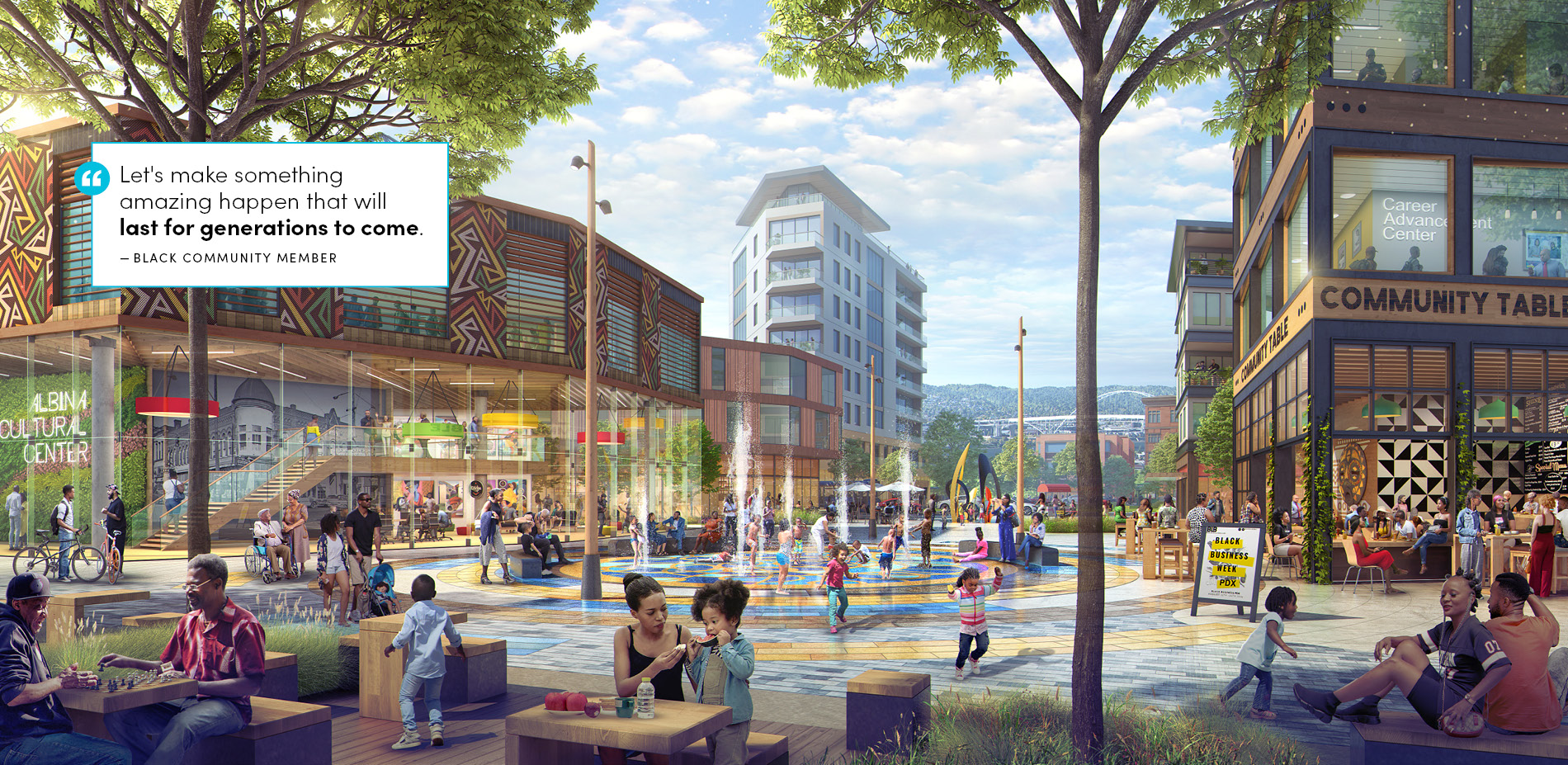Preparing the Ground: Restorative Justice on Portland's Interstate 5
Honor Award
Analysis and Planning
Portland, Oregon, United States
ZGF Architects
Client: Oregon Department of Transportation
Sixty years later, could a highway cover project create restorative justice outcomes for that primarily Black neighborhood? The Oregon Department of Transportation created an Independent Cover Assessment team to work with the community to find out. Stakeholders and community members focused on community health, wealth, and cohesion as their desired outcomes, which the team translated into high-quality development parcels, active and pedestrian-friendly streets, development flexibility, reduced highway impacts, and a highway cover to restore the local grid. The jury applauded the project as demonstrating how landscape design can be a tool for restorative justice.
- 2022 Awards Jury
Project Credits
ZGF Architects, Architecture, Team Lead, Urban Planning
!melk, Landscape Design
Suenn Ho Design, Community Service Program Lead
Olmsted LegacyTM, Environmental Assessment
Terry A. Hayes Associates (TAHA), Environmental Assessment
Arup, Technical Team Lead, Lead Freeway Cover Engineer, Strategic Infrastructure Planning
KPFF, Structural / Civil Engineer
Toole Design, Multimodal Assessment
HR&A Advisors, Governance Team Lead, Real Estate and Economic Development
Leland Consulting Group, Local Market Assessment
JM Woolley & Associates, Facilitator
Project Statement
How can a highway project create restorative justice outcomes for a community displaced by the construction of Interstate 5? This question was central to the Independent Cover Assessment of the Interstate 5 (I-5) Rose Quarter Improvement Project being administered by the Oregon Department of Transportation (ODOT).
Original construction of I-5 in 1962 displaced the heart of Portland’s Black community in the Lower Albina neighborhood. It claimed land and homes, compromised clean air, and disrupted business and community continuity. Black Portlanders were forced to start over without adequate compensation, making it difficult to build generational wealth. After Oregon’s legislature charged ODOT with improving a congestion bottleneck in the Albina area, local organizations called for highway covers that would reconnect the neighborhood, returning land to the displaced Black community. The Independent Cover Assessment team engaged stakeholders and community members in an independent and transparent process to examine how highway covers could lay the groundwork for restorative justice. While highway covers cannot undo prior damage, they can provide a solid foundation to build on for future generations.
Project Narrative
The Lower Albina neighborhood was a vibrant center of the Black community. The original construction of I-5 and subsequent urban renewal projects demolished its homes and businesses, choked the neighborhood with vehicle traffic, fractured the community and forced residents to relocate across the Portland metro area. Despite this diaspora, North and Northeast Portland remain cultural and emotional hubs for many Black Portlanders who were born and raised there. They hold the largest concentration of cultural institutions of Portland’s Black community and many members of the Black community strongly desire to revitalize and repopulate Historic Albina.
The original scope of ODOT’s Rose Quarter Improvement Project was to resolve a congestion bottleneck, improve mainline safety and operations and add more east to west connections across the highway. It included two highway covers to create new community spaces and enhance pedestrian connections in the Historic Albina neighborhood. It became apparent to the community, through concepts developed by the Albina Vision Trust, that the project could be leveraged to facilitate restorative justice for the Albina community. In 2020, in response to requests from local project stakeholders, the Oregon Transportation Commission directed ODOT to retain a consultant team of urban design, engineering, and environmental experts to conduct an independent assessment of the potential for highway covers. The Independent Cover Assessment team’s role was to work with residents and stakeholders who had been impacted by the freeway to understand their vision and goals for the highway covers and develop a range of design scenarios. The team sought to clearly represent design trade-offs and help them come to consensus.
Many members of the Albina community still vividly remember the impact of the brutal, discriminatory process that decimated their neighborhood. Their homes, jobs, and community were taken from them, causing understandable distrust of another public transportation project. The Independent Cover Assessment team purposefully centered the community in its process. To receive meaningful feedback, our team worked with a community facilitator who was well-known to the Black community. She brought the community to the table with direct outreach, building trust into the project and its outcomes. The team held three public work sessions to solicit input and feedback from community stakeholders, including residents, business owners, civic organizations, faith communities, public agencies and the general public. These work sessions generated feedback for the highway cover scenarios and identified implementation strategies for the final recommendation to the Oregon Transportation Commission.
Over the course of the work sessions the design team listened to what people said and reflected it back, helping stakeholders hear how their input was shaping the project and allowing them to ensure the Independent Cover Assessment team’s concepts accurately reflected the community’s shared aspirations. Ultimately, the team identified the community’s desired outcomes as: community health, community wealth, and community cohesion, which became the framework for design efforts and decision making moving forward. Serving these outcomes required design concepts with high-quality development parcels, active and pedestrian-friendly streets, development flexibility, and reduced highway impacts.
Stakeholders and community members shared diverse opinions on how best to satisfy community wealth goals: some favored building the project as quickly as possible to maximize near-term highway construction jobs, whereas others favored taking the time to maximize land delivered back to the community. The design team summarized the community’s feedback with strategies that could achieve both if they built, owned, and benefitted from the cover in the future. The timeframe in which the community received these benefits was crucial to the success of the project.
Some people shared a vision of community redevelopment that spanned the highway and extended to the river, rebuilding the community they could have had if the public sector hadn’t been rigged against them. It would take generations to reach this goal and the best support this project could provide was to maximize the amount and quality of land on which to build.
Local Black contractors shared a vision of social and economic uplift from their participation in this major infrastructure project; the type of project they would have been excluded from and harmed by in the past. They saw this project as an opportunity to provide family-wage jobs, establish generational wealth, and further their community’s careers in major infrastructure projects to provide long-term financial stability. They did not believe their community could wait on a project delay to receive this benefit.
The Independent Cover Assessment team created three design scenarios and three hybrid design scenarios that were responsive to stakeholder goals and visions. The community deliberated on trade-offs including schedule, amounts of land, and quality of land. The initial scenarios focused on creating the most land possible by moving freeway ramps and reconfiguring surface streets, which came with significant delays to the schedule and therefore delayed construction jobs for Black contractors. We provided both qualitative images and detailed quantitative information about the scenarios so community members could make well-informed decisions and reach consensus on a shared solution. The scenarios were evaluated against an assessment framework that included metrics on amount of developable land created, quality of street improvements, transit access, schedule impact, and project cost.
The team’s governance experts developed next steps with the community and public partners to prepare for community oversight, ownership, and management of the developable land created by the project.
Trust and collaboration can be difficult to achieve on any project. Communities, especially those who have experienced historic harm and discrimination from development projects, can be understandably wary of public engagement processes. The Independent Cover Assessment team recognized that the community are the experts on their own needs, working hard to build trust and ensure their voices were heard. The ultimate recommendation to the Oregon Transportation Commission was to move forward with the third hybrid scenario, which allows for more active streets, a greater amount of developable land, and more comfortable intersections with a lower impact to the original schedule.
The project has since earned the endorsement of Oregon leadership including Governor Kate Brown, Portland City Council Member and Transportation Commissioner Jo Ann Hardesty and Portland Metro Council President Lynn Peterson. More significantly, the residents of the Historic Albina neighborhood have been heard.
